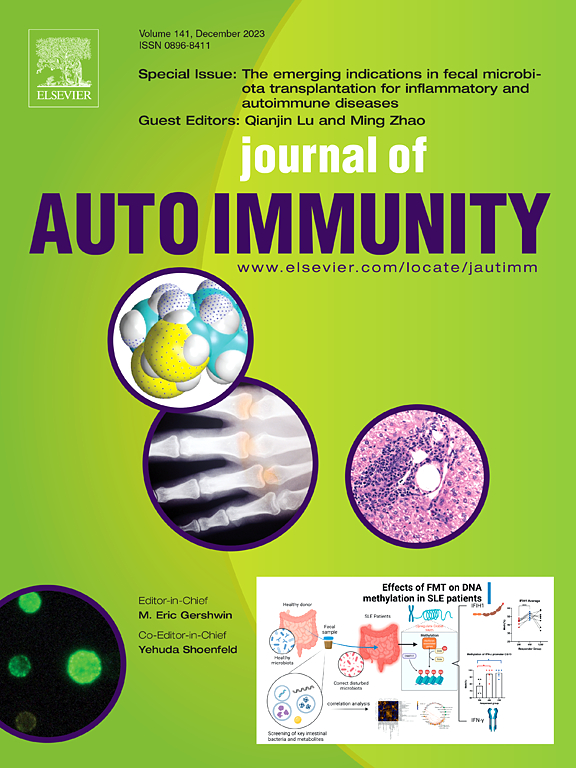PD1+先天淋巴样细胞3预测类风湿关节炎jak依赖性炎症
IF 7
1区 医学
Q1 IMMUNOLOGY
引用次数: 0
摘要
先天淋巴样细胞(ILCs)在维持免疫稳态中发挥关键作用,并与炎症和自身免疫有关。本研究调查了ilc在类风湿关节炎(RA)发病机制中的作用及其对两种靶向治疗的反应-阻断其激活所需的关键信号通路的JAK抑制剂(JAKi)和靶向关键炎症介质的TNF抑制剂(TNFi) -提供了这些干预如何形成ilc驱动的炎症的见解。如DAS28评分所示,ILC分布与RA活性相关,并且这种不平衡在JAKi的四周内显着改善,强调其对ILC介导的炎症的早期治疗作用。虽然在JAKi治疗下IL-1β和IL-23等ilc3激活细胞因子水平下降,但在TNFi治疗下它们保持不变。虽然JAKi和TNFi的治疗效果相似,但多因素回归分析显示,DAS28评分的改善仅与JAKi的CTLA-4+ILC3升高、PD1+ILC3频率和全身IL12p40/IL-23水平降低密切相关。值得注意的是,这两种ILC3亚型决定了JAKi 50 d后的DAS28评分。相比之下,对JAKi反应有限的患者(ΔDAS28 <;1.2)维持高的全身IL-18水平,IL-18是一种独立于JAK途径诱导信号的细胞因子,提示潜在的耐药机制。这些发现强调,监测PD1+ILC3s或IL-12p40/IL-23可能作为JAKi反应性的指标,而升高的IL-18可能确定患者受益于替代疗法。这些结果也强调了靶向先天免疫的临床相关性,以实现更个性化的、以途径为重点的类风湿性关节炎治疗。本文章由计算机程序翻译,如有差异,请以英文原文为准。
PD1+ innate lymphoid cells 3 predict JAK-dependent inflammation in rheumatoid arthritis
Innate lymphoid cells (ILCs) play a key role in maintaining immune homeostasis and are linked to inflammation and autoimmunity. This study investigates the role of ILCs in the pathogenesis of rheumatoid arthritis (RA) and their response to two targeted therapies - JAK inhibitors (JAKi), which block critical signaling pathways required for their activation, and TNF inhibitors (TNFi), which target a key inflammatory mediator - offering insights into how these interventions shape ILC-driven inflammation.
ILC distribution correlated with RA activity, as indicated by the DAS28 score, and this imbalance was improved significantly within four weeks of JAKi, underscoring its early therapeutic impact on ILC-mediated inflammation. While levels of ILC3-activating cytokines such as IL-1β and IL-23 declined under JAKi therapy, they remained unchanged with TNFi. Although JAKi and TNFi showed similar treatment efficacy, multivariate regression analysis showed that improvement in DAS28 score was strongly associated with increase in CTLA-4+ILC3 and reduction in both PD1+ILC3 frequency and systemic IL12p40/IL-23 levels only with JAKi. Notably, this two ILC3 subtypes determined the DAS28 score after 50 d of JAKi. In contrast, patients showing limited response to JAKi (ΔDAS28 < 1.2) maintained high systemic IL-18 levels, a cytokine that induces signaling independent of the JAK pathway, suggesting a potential resistance mechanism. These findings highlight that monitoring PD1+ILC3s or IL-12p40/IL-23 may serve as an indicator of JAKi responsiveness, while elevated IL-18 may identify patients benefiting from alternative therapies. These results also emphasize the clinical relevance of targeting innate immunity for more personalized, pathway-focused RA therapies.
求助全文
通过发布文献求助,成功后即可免费获取论文全文。
去求助
来源期刊

Journal of autoimmunity
医学-免疫学
CiteScore
27.90
自引率
1.60%
发文量
117
审稿时长
17 days
期刊介绍:
The Journal of Autoimmunity serves as the primary publication for research on various facets of autoimmunity. These include topics such as the mechanism of self-recognition, regulation of autoimmune responses, experimental autoimmune diseases, diagnostic tests for autoantibodies, as well as the epidemiology, pathophysiology, and treatment of autoimmune diseases. While the journal covers a wide range of subjects, it emphasizes papers exploring the genetic, molecular biology, and cellular aspects of the field.
The Journal of Translational Autoimmunity, on the other hand, is a subsidiary journal of the Journal of Autoimmunity. It focuses specifically on translating scientific discoveries in autoimmunity into clinical applications and practical solutions. By highlighting research that bridges the gap between basic science and clinical practice, the Journal of Translational Autoimmunity aims to advance the understanding and treatment of autoimmune diseases.
 求助内容:
求助内容: 应助结果提醒方式:
应助结果提醒方式:


